Efficient Estimation of Biomass from Residual Agroforestry
Abstract
:1. Introduction
2. Materials and Methods
2.1. Study Area
2.2. Definition of the Sampling Populations
2.3. Auxiliary Variable from Remote Sensing
2.4. Sampling Design
2.5. Photo-Interpretation of Potential Residual Biomass Density in the Sample Plots
3. Results
4. Discussion
Author Contributions
Funding
Conflicts of Interest
References
- Xie, Y.; Sha, Z.; Yu, M. Remote sensing imagery in vegetation mapping: A review. J. Plant Ecol. 2008, 1, 9–23. [Google Scholar] [CrossRef]
- Gallego, J. Use of remote sensing for the design of sampling frames. In Handbook of the Global Strategy to Improve Agricultural and Rural Statistics (GSARS); Delincé, J., Ed.; GSARS: Rome, Italy, 2017. [Google Scholar]
- GSARS. Handbook on Remote Sensing for Agricultural Statistics; GSARS: Rome, Italy, 2017. [Google Scholar]
- Gregoire, T.G.; Valentine, H.T. Ranked set sampling. In Sampling Strategies for Natural Resources and the Environment; Applied Environmental Statistics; Chapmann & Hall/CRC: New York, NY, USA, 2008; p. 474. [Google Scholar]
- Bascietto, M.; De Cinti, B.; Matteucci, G.; Cescatti, A. Biometric assessment of aboveground carbon pools and fluxes in three European forests by Randomized Branch Sampling. For. Ecol. Manag. 2012, 267, 172–181. [Google Scholar] [CrossRef]
- Chen, Z. The efficiency of ranked-set sampling relative to simple random sampling under multi-parameter families. Stat. Sin. 2000, 10, 247–263. [Google Scholar]
- Anttila, P.; Vaario, L.-M.; Pulkkinen, P.; Asikainen, A.; Duan, J. Availability, supply technology and costs of residual forest biomass for energy—A case study in northern China. Biomass Bioenergy 2015, 83, 224–232. [Google Scholar] [CrossRef]
- de Jong, S.; Hoefnagels, R.; Wetterlund, E.; Pettersson, K.; Faaij, A.; Junginger, M. Cost optimization of biofuel production—The impact of scale, integration, transport and supply chain configurations. Appl. Energy 2017, 195, 1055–1070. [Google Scholar] [CrossRef] [Green Version]
- Bout, A.E.; Pfau, S.F.; Van Der Krabben, E.; Dankbaar, B. Residual Biomass from Dutch Riverine Areas—From Waste to Ecosystem Service. Sustain 2019, 11, 509. [Google Scholar] [CrossRef] [Green Version]
- Evans, A.; Strezov, V.; Evans, T.J. Sustainability considerations for electricity generation from biomass. Renew. Sustain. Energy Rev. 2010, 14, 1419–1427. [Google Scholar] [CrossRef]
- Pfau, S. Residual Biomass: A Silver Bullet to Ensure a Sustainable Bioeconomy? In Proceedings of the the European Conference on Sustainability, Energy & the Environment 2015, Brighton, UK, 9–12 July 2015; pp. 295–312. [Google Scholar]
- Verani, S.; Sperandio, G.; Picchio, R.; Marchi, E.; Costa, C. Sustainability Assessment of a Self-Consumption Wood-Energy Chain on Small Scale for Heat Generation in Central Italy. Energies 2015, 8, 5182–5197. [Google Scholar] [CrossRef] [Green Version]
- Schubert, R. (Ed.) Future Bioenergy and Sustainable Land Use; Earthscan: London, UK, 2010; ISBN 978-1-84407-841-7. [Google Scholar]
- Caputo, A.C.; Palumbo, M.; Pelagagge, P.M.; Scacchia, F. Economics of biomass energy utilization in combustion and gasification plants: Effects of logistic variables. Biomass Bioenergy 2005, 28, 35–51. [Google Scholar] [CrossRef]
- Dornburg, V.; Faaij, A.P.C. Effciency and economy of wood-fired biomass energy systems in relation to scale regarding heat and power generation using combustion and gasification technologies. Biomass Bioenergy 2001, 21, 91–108. [Google Scholar] [CrossRef]
- Kanzian, C.; Kühmaier, M.; Zazgornik, J.; Stampfer, K. Design of forest energy supply networks using multi-objective optimization. Biomass Bioenergy 2013, 58, 294–302. [Google Scholar] [CrossRef]
- Galidaki, G.; Zianis, D.; Gitas, I.; Radoglou, K.; Karathanassi, V.; Tsakiri–Strati, M.; Woodhouse, I.; Mallinis, G. Vegetation biomass estimation with remote sensing: Focus on forest and other wooded land over the Mediterranean ecosystem. Int. J. Remote Sens. 2017, 38, 1940–1966. [Google Scholar] [CrossRef] [Green Version]
- Fayad, I.; Baghdadi, N.; Guitet, S.; Bailly, J.-S.; Hérault, B.; Gond, V.; Hajj, M.E.; Minh, D.H.T. Aboveground biomass mapping in French Guiana by combining remote sensing, forest inventories and environmental data. Int. J. Appl. Earth Obs. Geoinf. 2016, 52, 502–514. [Google Scholar] [CrossRef] [Green Version]
- Otgonbayar, M.; Atzberger, C.; Chambers, J.; Damdinsuren, A. Mapping pasture biomass in Mongolia using Partial Least Squares, Random Forest regression and Landsat 8 imagery. Int. J. Remote Sens. 2019, 40, 3204–3226. [Google Scholar] [CrossRef]
- Kasampalis, D.; Alexandridis, T.; Deva, C.; Challinor, A.; Moshou, D.; Zalidis, G. Contribution of Remote Sensing on Crop Models: A Review. J. Imaging 2018, 4, 52. [Google Scholar] [CrossRef] [Green Version]
- Ginaldi, F.; Bajocco, S.; Bregaglio, S.; Cappelli, G. Spatializing Crop Models for Sustainable Agriculture. In Innovations in Sustainable Agriculture; Farooq, M., Pisante, M., Eds.; Springer International Publishing: Cham, The Netherlands, 2019; pp. 599–619. ISBN 978-3-030-23169-9. [Google Scholar]
- Latifi, H.; Fassnacht, F.E.; Hartig, F.; Berger, C.; Hernández, J.; Corvalán, P.; Koch, B. Stratified aboveground forest biomass estimation by remote sensing data. Int. J. Appl. Earth Obs. Geoinf. 2015, 38, 229–241. [Google Scholar] [CrossRef]
- Yadav, B.K.V.; Nandy, S. Mapping aboveground woody biomass using forest inventory, remote sensing and geostatistical techniques. Environ. Monit. Assess. 2015, 187, 308. [Google Scholar] [CrossRef]
- Chen, Z.; Bai, Z.; Sinha, B.K. Ranked Set Sampling: Theory and Applications; Lecture Notes in Statistics; Springer: New York, NY, USA, 2003; Volume 176. [Google Scholar]
- Galluzzo, N. Analisi Economica, Indagini di Marketing e Prospettive Operative Dell’olivicoltura Nelle Zone Interne Della Regione Lazio: Un Caso di Studio Nell’area di Produzione Dell’olio Sabina DOP; Aracne: Roma, Italy, 2009; ISBN 978-88-548-1694-7. [Google Scholar]
- Lepre, S. Gli Archivi Dell’agricoltura Del Territorio di Roma e Del Lazio; Pubblicazioni Degli Archivi di Stato; Ministero Per i Beni e le Attività Culturali, Direzione Generale Per Gli Archivi: Roma, Italy, 2009; Volume 96.
- Luxen, D.; Vetter, C. Real-time routing with OpenStreetMap data. In Proceedings of the 19th ACM SIGSPATIAL International Conference on Advances in Geographic Information Systems, Chicago, IL, USA, 1–4 November 2011; ACM: New York, NY, USA, 2011; pp. 513–516. [Google Scholar]
- Copernicus Land Monitoring Service Corine Land Cover 2018. Available online: https://land.copernicus.eu/pan-european/corine-land-cover/clc2018 (accessed on 4 July 2019).
- Tucker, C.J. Red and photographic infrared linear combinations for monitoring vegetation. Remote Sens. Environ. 1979, 8, 127–150. [Google Scholar] [CrossRef] [Green Version]
- Myneni, R.B.; Hall, F.G.; Sellers, P.J.; Marshak, A.L. The Interpretation of Spectral Vegetation Indexes. Trans. Geosci. Remote Sens. 1995, 33, 481–486. [Google Scholar] [CrossRef]
- Sellers, P.J. Canopy reflectance, photosynthesis and transpiration. Int. J. Remote Sens. 1985, 6, 1335–1372. [Google Scholar] [CrossRef]
- Wang, J.; Rich, P.M.; Price, K.P.; Kettle, W.D. Relations between NDVI and tree productivity in the central Great Plains. Int. J. Remote Sens. 2004, 25, 3127–3138. [Google Scholar] [CrossRef]
- Drusch, M.; Del Bello, U.; Carlier, S.; Colin, O.; Fernandez, V.; Gascon, F.; Hoersch, B.; Isola, C.; Laberinti, P.; Martimort, P.; et al. Sentinel-2: ESA’s Optical High-Resolution Mission for GMES Operational Services. Remote Sens. Environ. 2012, 120, 25–36. [Google Scholar] [CrossRef]
- Puletti, N.; Bascietto, M. Towards a Tool for Early Detection and Estimation of Forest Cuttings by Remotely Sensed Data. Land 2019, 8, 58. [Google Scholar] [CrossRef] [Green Version]
- Gorelick, N.; Hancher, M.; Dixon, M.; Ilyushchenko, S.; Thau, D.; Moore, R. Google Earth Engine: Planetary-scale geospatial analysis for everyone. Remote Sens. Environ. 2017, 202, 18–27. [Google Scholar] [CrossRef]
- McIntyre, G.A. A Method for Unbiased Selective Sampling, Using Ranked Sets. Aust. J. Agric. Res. 1952, 3, 385–390. [Google Scholar] [CrossRef]
- Martin, W.L.; Shank, T.L.; Oderwald, R.G.; Smith, D.W. Evaluation of Ranked Set Sampling for Estimating Shrub Phytomass in Appalachian Oak Forest; School of Forestry and Widlife Resources VPI&SU: Blacksburg, VA, USA, 1980. [Google Scholar]
- Gilbert, R.O.; Eberhardt, L.L. An evaluation of double sampling for estimating plutonium inventory in surface soil. In Radioecology and Energy Sources; Dowden, Hutchinson and Ross: Stroudsburg, PA, USA, 1976; pp. 157–163. [Google Scholar]
- Chen, Z. Adaptive ranked set sampling scheme with multiple concomitant variables: An effective way to observational economy. Bernoulli 2002, 8, 313–322. [Google Scholar]
- Silva, P.L.D.N.; Skinner, C.J. Variable selection for regression estimation in finite population. Surv. Methodol. 1997, 23, 23–32. [Google Scholar]
- Risch, N.; Zhang, H. Extreme discordant sib pairs for mapping quantitative trait loci in humans. Science 1995, 268, 1584–1589. [Google Scholar] [CrossRef]
- Jeelani, M.I.; Bouza, C.N.; Sautto, J.M. Efficiency of Ranked Set Sampling in Horticultural Surveys. Cadernos do IME-Série Estatística 2015, 38, 37. [Google Scholar] [CrossRef]
- Uribeetxebarria, A.; Martínez-Casasnovas, J.A.; Tisseyre, B.; Guillaume, S.; Escolà, A.; Rosell-Polo, J.R.; Arnó, J. Assessing ranked set sampling and ancillary data to improve fruit load estimates in peach orchards. Comput. Electron. Agric. 2019, 164, 104931. [Google Scholar] [CrossRef]
- Spinelli, R.; Picchi, G. Industrial harvesting of olive tree pruning residue for energy biomass. Bioresour. Technol. 2010, 730–735. [Google Scholar] [CrossRef] [PubMed]
- Manzanares, P.; Ruiz, E.; Ballesteros, M.; Negro, M.J.; Gallego, F.J.; López-Linares, J.C.; Castro, E. Residual biomass potential in olive tree cultivation and olive oil industry in Spain: Valorization proposal in a biorefinery context. Span. J. Agric. Res. 2017, 15, e0206. [Google Scholar] [CrossRef] [Green Version]
- Romero-García, J.M.; Niño, L.; Martínez-Patiño, C.; Álvarez, C.; Castro, E.; Negro, M.J. Biorefinery based on olive biomass. State of the art and future trends. Bioresour. Technol. 2014, 159, 421–432. [Google Scholar] [CrossRef] [PubMed]
- Dipartimento Tutela ambientale e del Verde—Protezione Civile. Natura e Verde Pubblico. Relazione Sullo Stato Dell’ambiente; Roma Capitale: Rome, Italy, 2012. [Google Scholar]
- Di Blasi, C.; Tanzi, V.; Lanzetta, M. A study on the production of agricultural residues in Italy. Biomass Bioenergy 1997, 12, 321–331. [Google Scholar] [CrossRef]
- Manzone, M.; Paravidino, E.; Bonifacino, G.; Balsari, P. Biomass availability and quality produced by vineyard management during a period of 15 years. Renew. Energy 2016, 99, 465–471. [Google Scholar] [CrossRef]
- Quatrini, V.; Mattioli, W.; Romano, R.; Corona, P. Caratteristiche produttive e gestione dei cedui in Italia. Ital. For. Mont. 2017, 273–313. [Google Scholar] [CrossRef] [Green Version]
- Alam, B. Road Network Optimization Model for Supplying Woody Biomass Feedstock for Energy Production in Northwestern Ontario. Open For. Sci. J. 2012, 5, 1–14. [Google Scholar] [CrossRef] [Green Version]
- Velazquez-Marti, B.; Fernandez-Gonzalez, E. Mathematical algorithms to locate factories to transform biomass in bioenergy focused on logistic network construction. Renew. Energy 2010, 35, 2136–2142. [Google Scholar] [CrossRef]
- Dell, T.R.; Clutter, J.L. Ranked set sampling theory with order statistics background. Biometrics 1972, 28, 545–555. [Google Scholar] [CrossRef]
- Okello, C.; Pindozzi, S.; Faugno, S.; Boccia, L. Bioenergy potential of agricultural and forest residues in Uganda. Biomass Bioenergy 2013, 56, 515–525. [Google Scholar] [CrossRef]
- Beringer, T.; Lucht, W.; Schaphoff, S. Bioenergy production potential of global biomass plantations under environmental and agricultural constraints. GCB Bioenergy 2011, 3, 299–312. [Google Scholar] [CrossRef]
- Palomo, I.; Willemen, L.; Drakou, E.; Burkhard, B.; Crossman, N.; Bellamy, C.; Burkhard, K.; Campagne, C.S.; Dangol, A.; Franke, J.; et al. Practical solutions for bottlenecks in ecosystem services mapping. One Ecosyst. 2018, 3, e20713. [Google Scholar] [CrossRef]
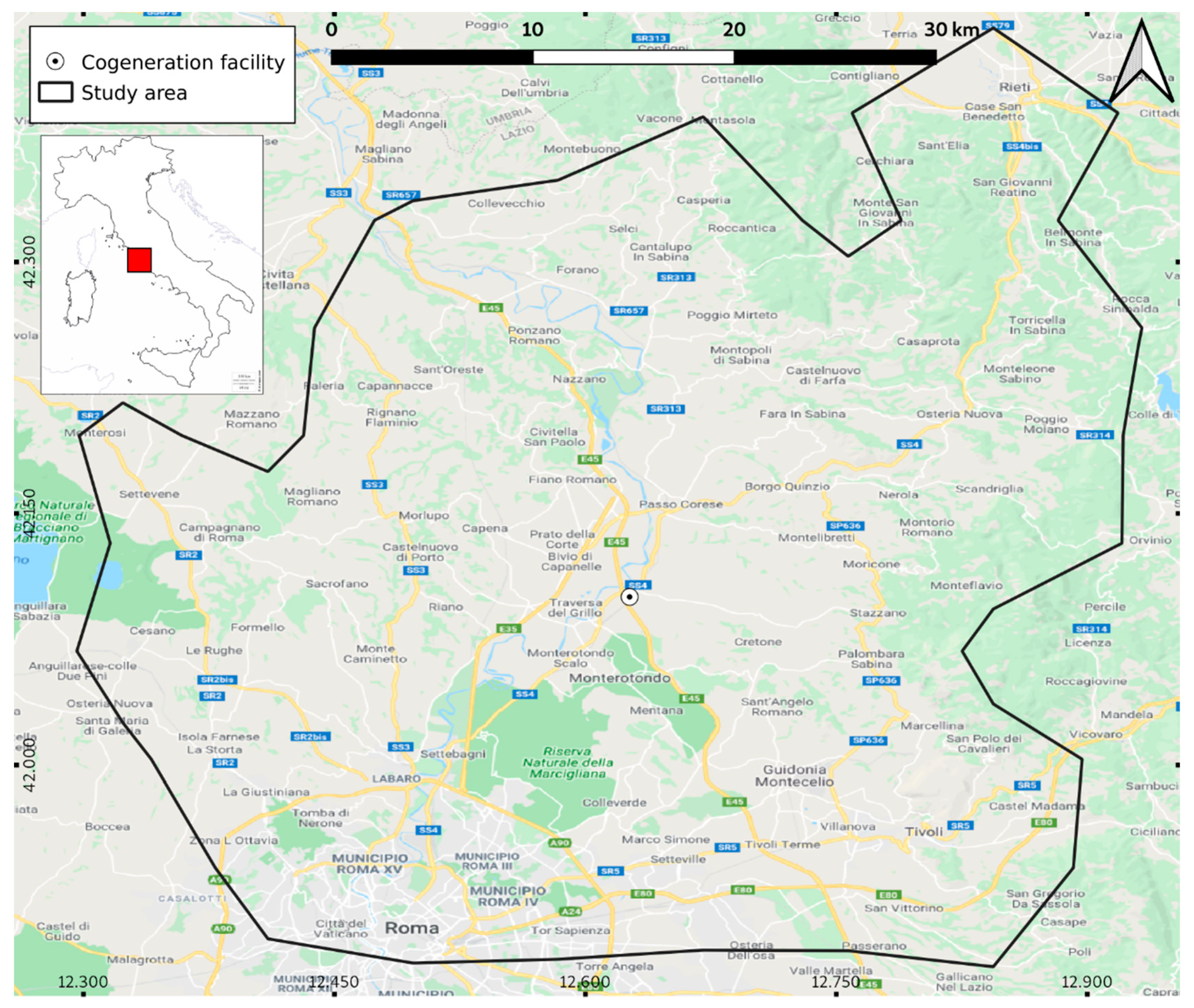
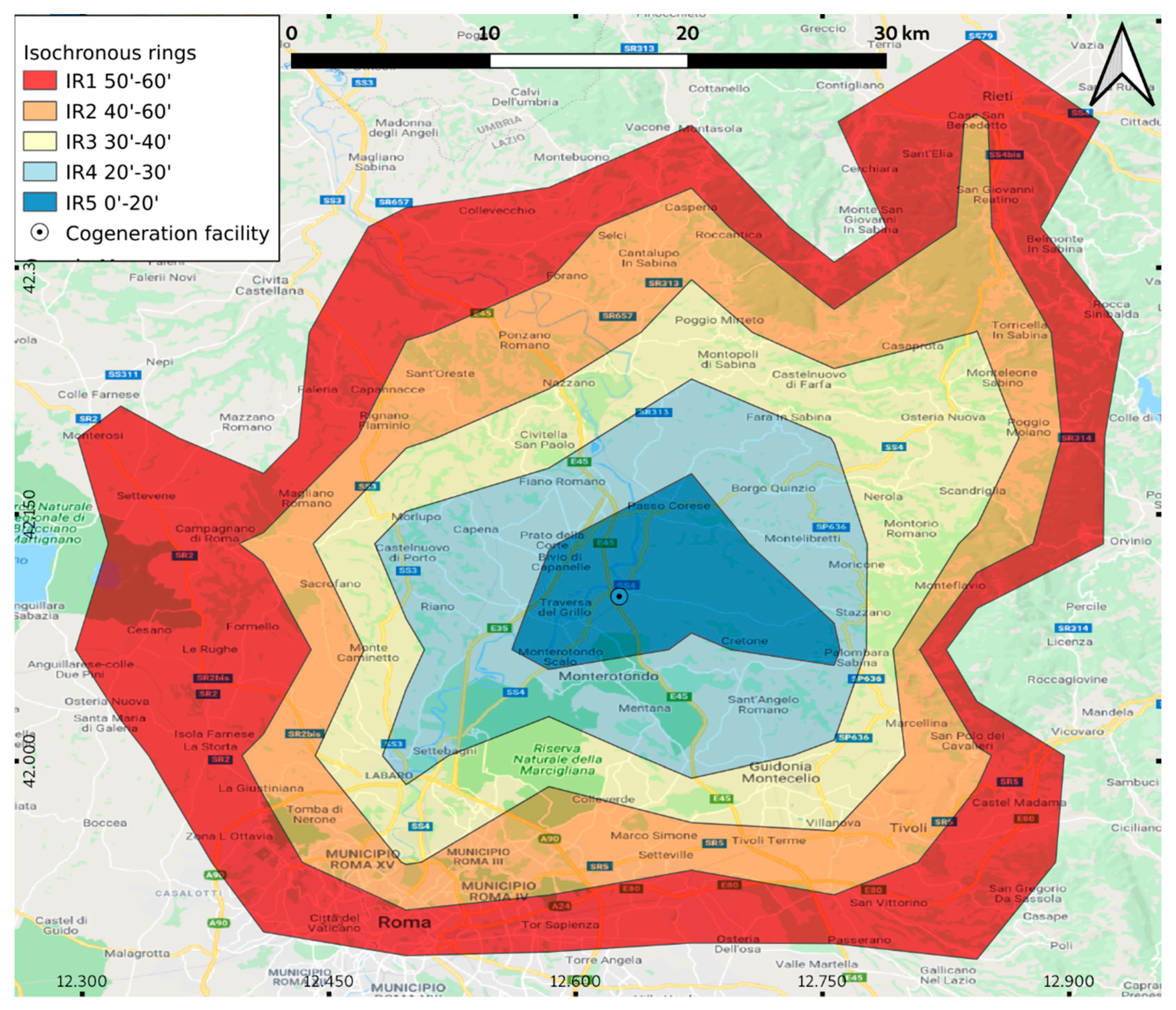
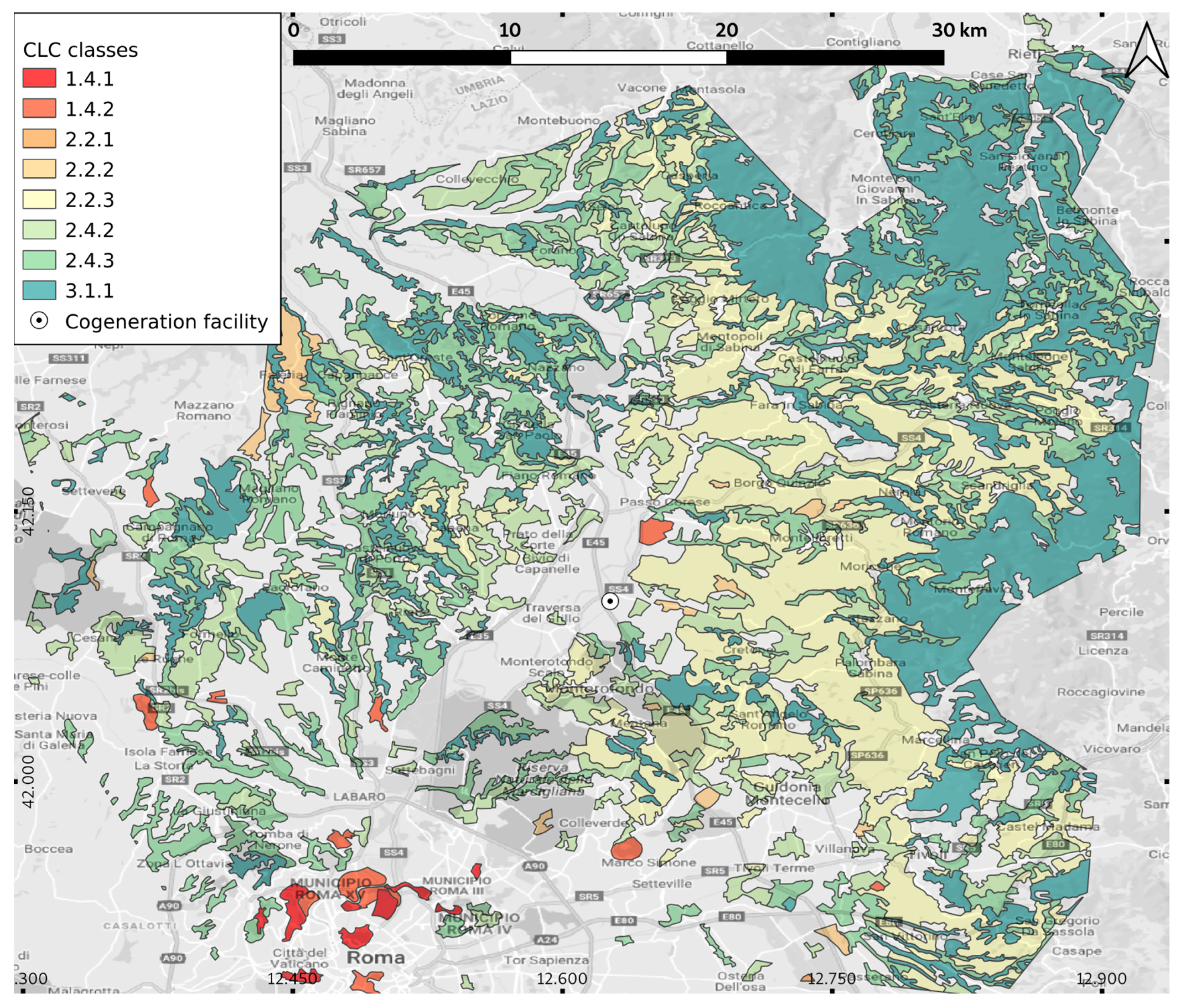
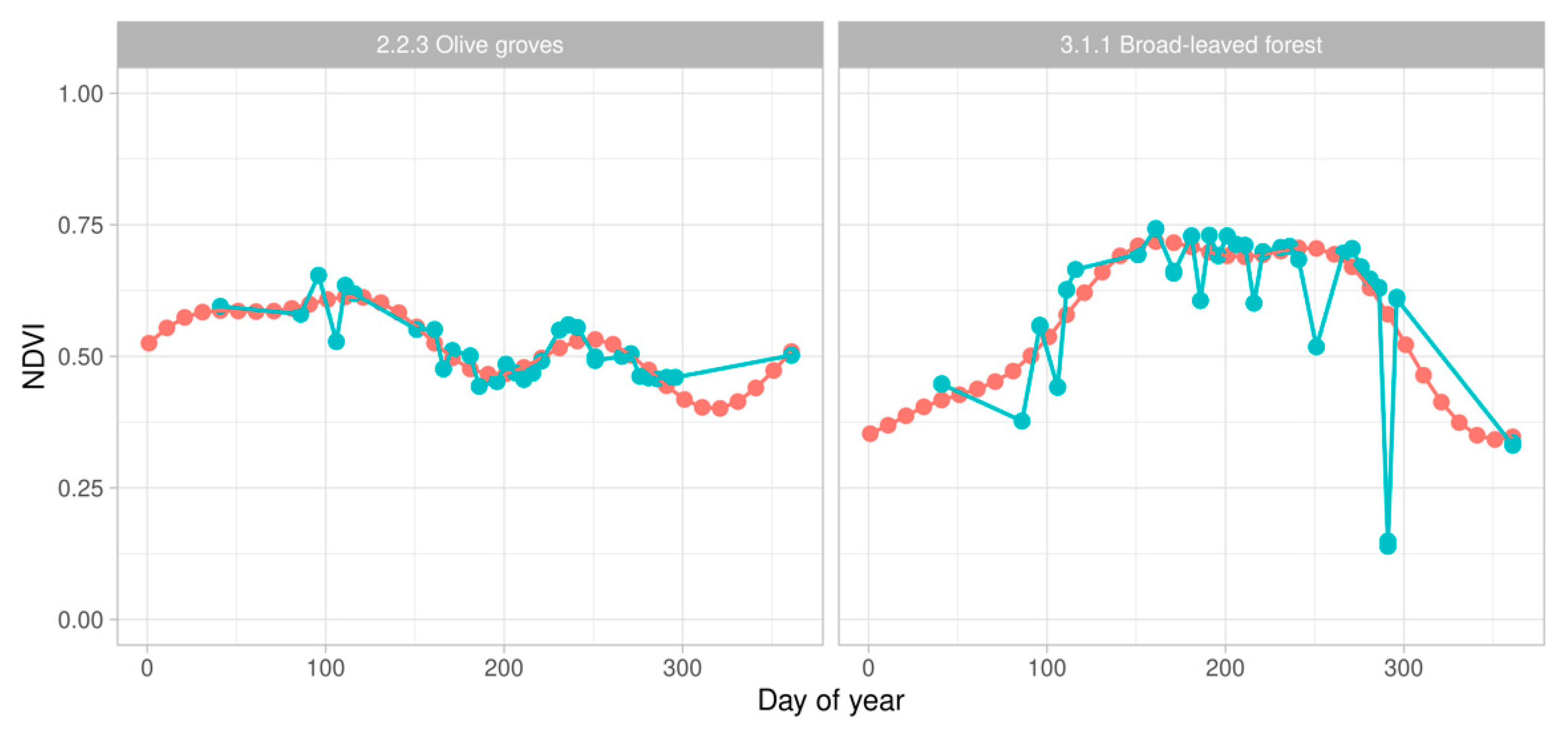
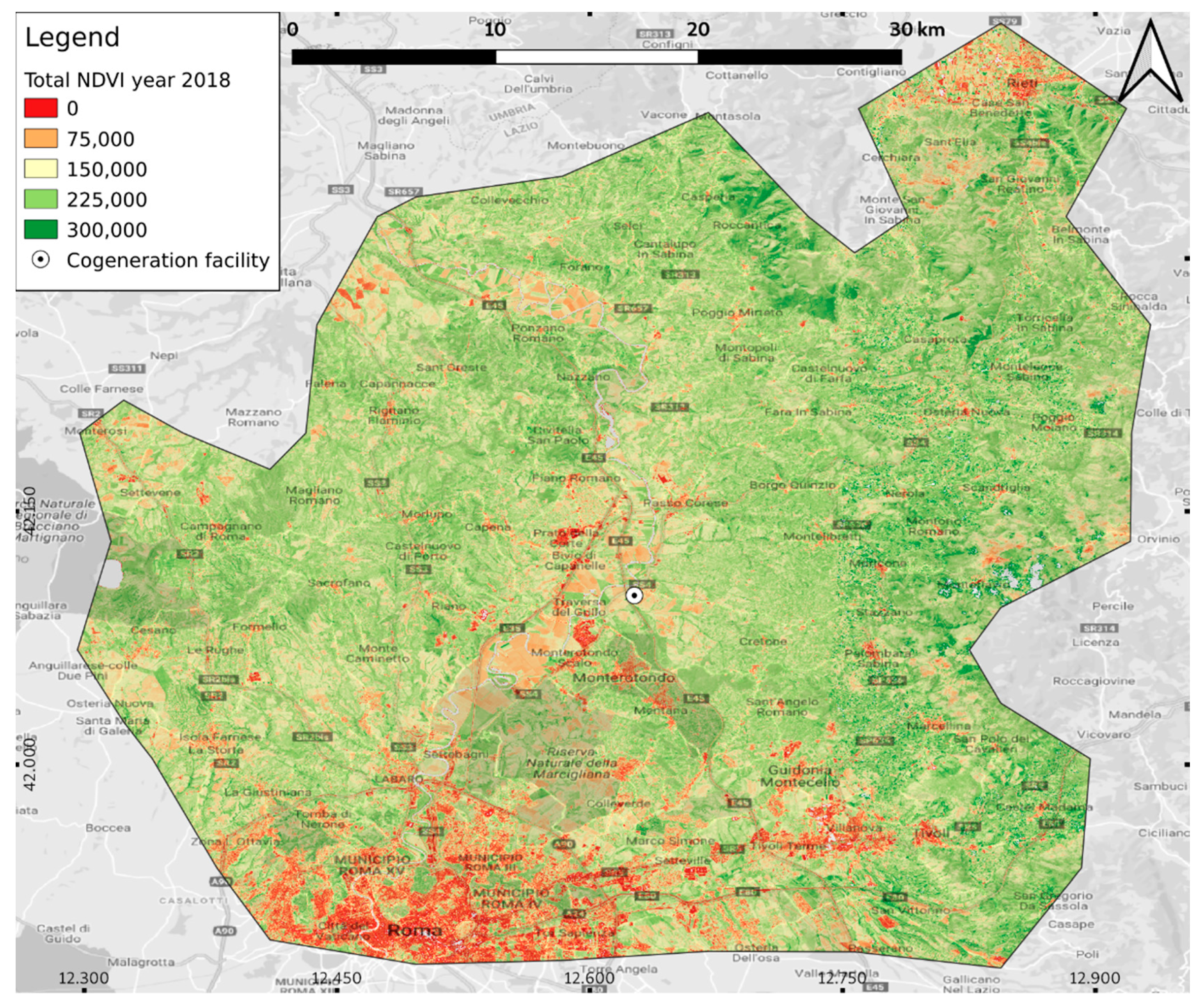
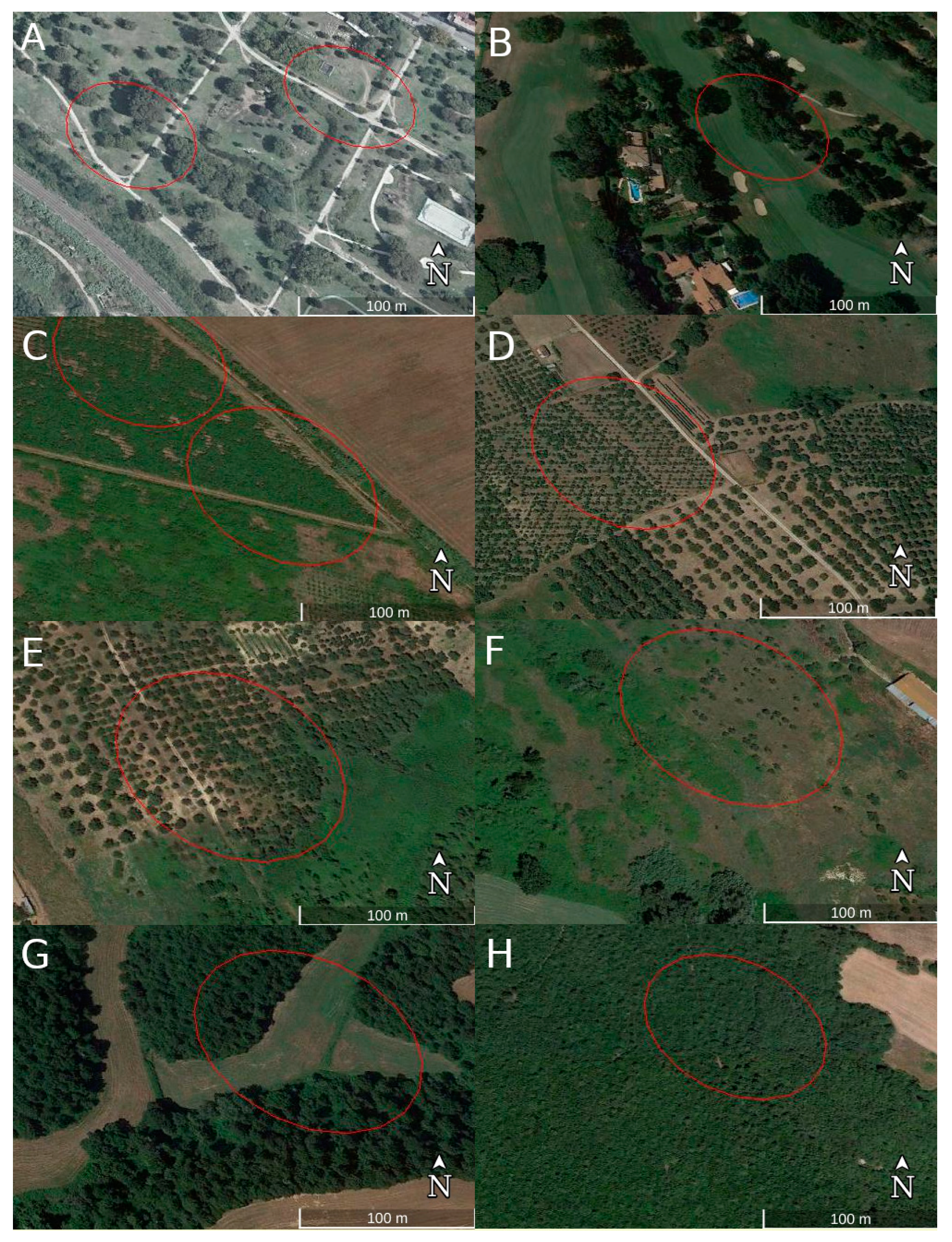
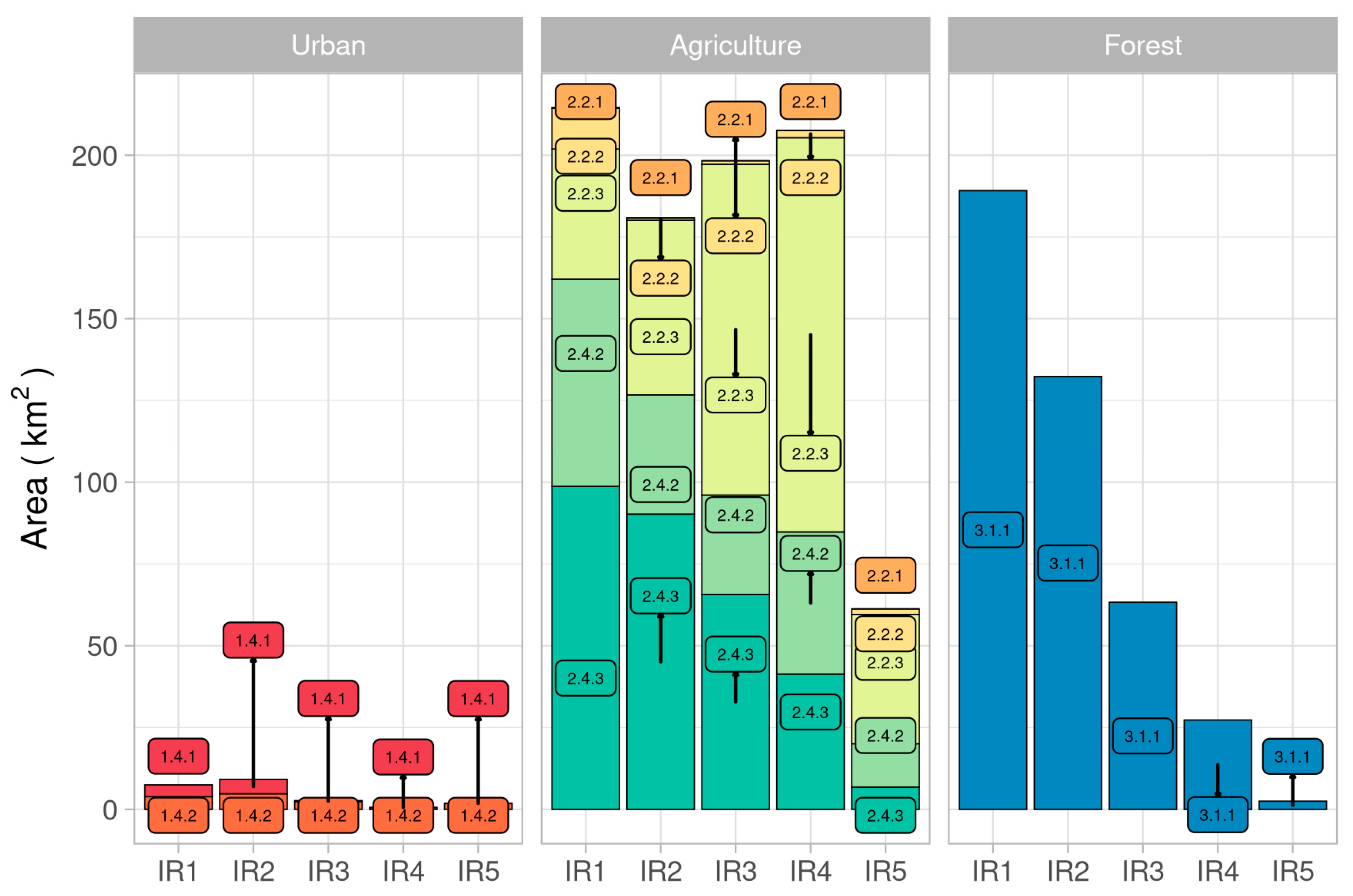

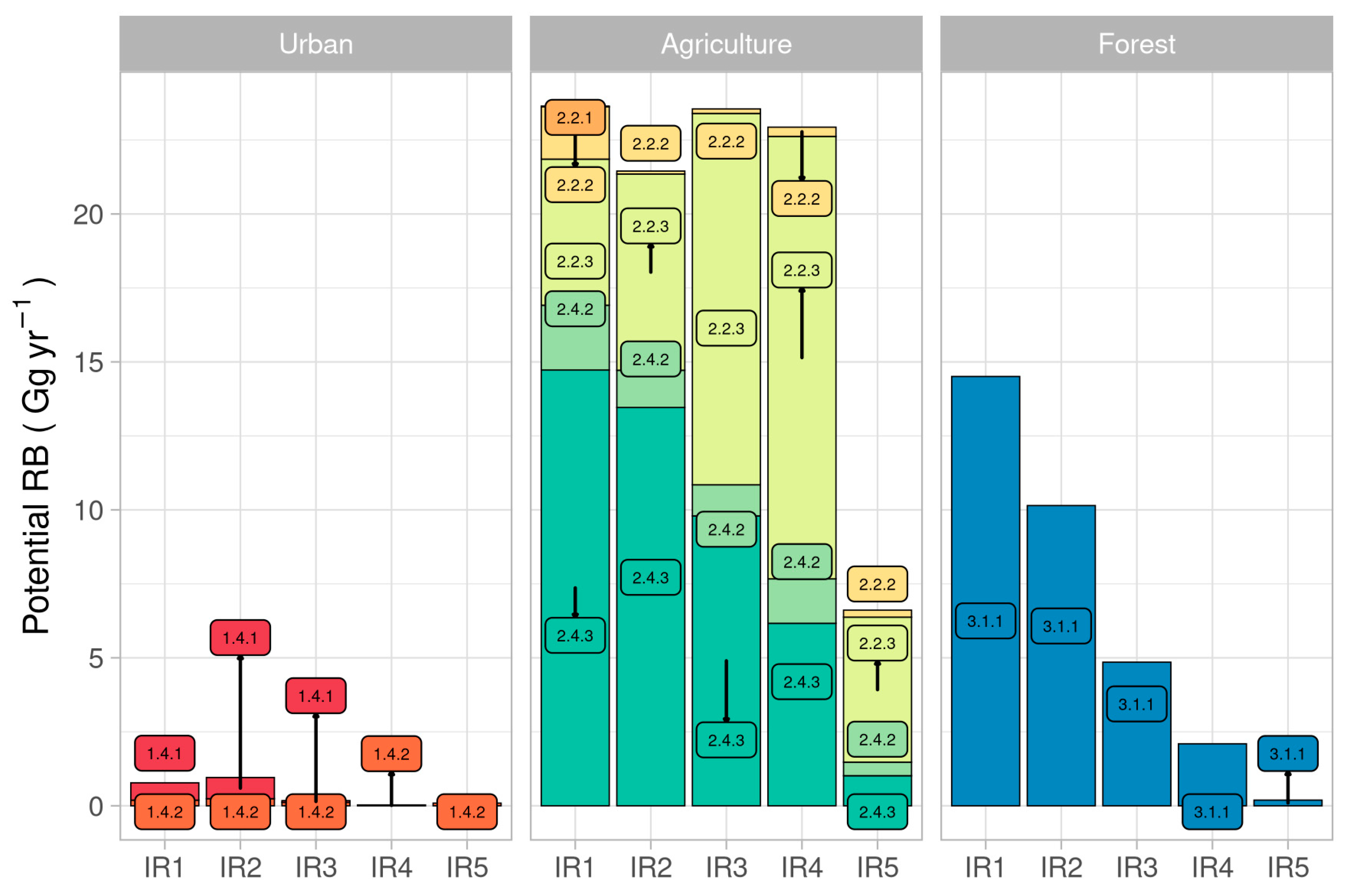
| Ring Code | Min Time | Max Time | Area |
|---|---|---|---|
| IR1 | 50 | 60 | 821 |
| IR2 | 40 | 50 | 542 |
| IR3 | 30 | 40 | 433 |
| IR4 | 20 | 30 | 354 |
| IR5 | 0 | 20 | 126 |
| All IRs | 2276 |
| CLC Class | Land Cover Typology | CLC Label | Area |
|---|---|---|---|
| 1.4.1 | Urban | Green urban areas | 8.32 |
| 1.4.2 | Urban | Sport and leisure facilities | 13.3 |
| 2.2.1 | Agriculture | Vineyards | 0.165 |
| 2.2.2 | Agriculture | Fruit trees and berry plantations | 18.2 |
| 2.2.3 | Agriculture | Olive groves | 355 |
| 2.4.2 | Agriculture | Complex cultivation patterns | 187 |
| 2.4.3 | Agriculture | Land principally occupied by agriculture | 303 |
| 3.1.1 | Forest | Broad-leaved forest | 415 |
| All CLCs | 1296 |
| CLC Class | k | n | RP Upper Bound | Random Sample | Ranked Set Sample | Discarded Sample |
|---|---|---|---|---|---|---|
| 1.4.1 Green urban area | 3 | 3 | 2.0 | 27 | 9 | 18 |
| 1.4.2 Sport and leisure facilities | 3 | 3 | 2.0 | 27 | 9 | 18 |
| 2.2.1 Vineyards | 2 | 2 | 1.5 | 8 | 4 | 4 |
| 2.2.2 Fruit trees and berry plantations | 4 | 3 | 2.0 | 36 | 12 | 24 |
| 2.2.3 Olive groves | 7 | 5 | 4.0 | 180 | 35 | 145 |
| 2.4.2 Complex cultivation patterns | 7 | 5 | 4.0 | 180 | 35 | 145 |
| 2.4.3 Land principally occupied by agriculture | 5 | 4 | 3.0 | 80 | 20 | 60 |
| 3.1.1 Broad-leaved forest | 3 | 5 | 2.0 | 75 | 15 | 60 |
| Total | 745 | 139 | 606 |
| CLC Class | RB Per Tree, bc (Mg tree−1) | Tree Density, dc (Tree ha−1) | Time between Operations, y (Year) | RB Per Ha, bcdc (Mg ha−1) | Bc (Mg ha−1 yr−1) | References |
|---|---|---|---|---|---|---|
| 1.4.1 Green urban area | 0.4/0.3/0.2 | 80 | 8 | 4.0/3.0/2.0 | [47] | |
| 1.4.2 Sport and leisure facilities | 0.4/0.3/0.2 | 50 | 8 | 2.5/1.9/1.3 | [47] | |
| 2.2.1 Vineyards | 0.00075/0.00075/0.00070 | 4000/3400/3000 | 1 | 3.0/2.6/2.1 | [44,48,49] | |
| 2.2.2 Fruit trees and berry plantations | 0.007/0.0055/0.005 | 500/500/400 | 1 | 3.5/2.8/2.0 | [48] | |
| 2.2.3 Olive groves | 0.027/0.025/0.020 | 300/230/180 | 2 | 4.0/2.9/1.8 | [44,45,46] | |
| 2.4.2 Complex cultivation patterns | 0.015 | 260/200/130 | 2 | 2.0/1.5/1.0 | [48] | |
| 2.4.3 Land principally occupied by agriculture use | 0.007/0.0055/0.005 | 500/500/400 | 1 | 3.5/2.8/2.0 | [48] | |
| 3.1.1 Broad-leaved forests | 25 | 26/23/19 | 1.1/0.90/0.75 | [50] |
© 2020 by the authors. Licensee MDPI, Basel, Switzerland. This article is an open access article distributed under the terms and conditions of the Creative Commons Attribution (CC BY) license (http://creativecommons.org/licenses/by/4.0/).
Share and Cite
Bascietto, M.; Sperandio, G.; Bajocco, S. Efficient Estimation of Biomass from Residual Agroforestry. ISPRS Int. J. Geo-Inf. 2020, 9, 21. https://0-doi-org.brum.beds.ac.uk/10.3390/ijgi9010021
Bascietto M, Sperandio G, Bajocco S. Efficient Estimation of Biomass from Residual Agroforestry. ISPRS International Journal of Geo-Information. 2020; 9(1):21. https://0-doi-org.brum.beds.ac.uk/10.3390/ijgi9010021
Chicago/Turabian StyleBascietto, Marco, Giulio Sperandio, and Sofia Bajocco. 2020. "Efficient Estimation of Biomass from Residual Agroforestry" ISPRS International Journal of Geo-Information 9, no. 1: 21. https://0-doi-org.brum.beds.ac.uk/10.3390/ijgi9010021






